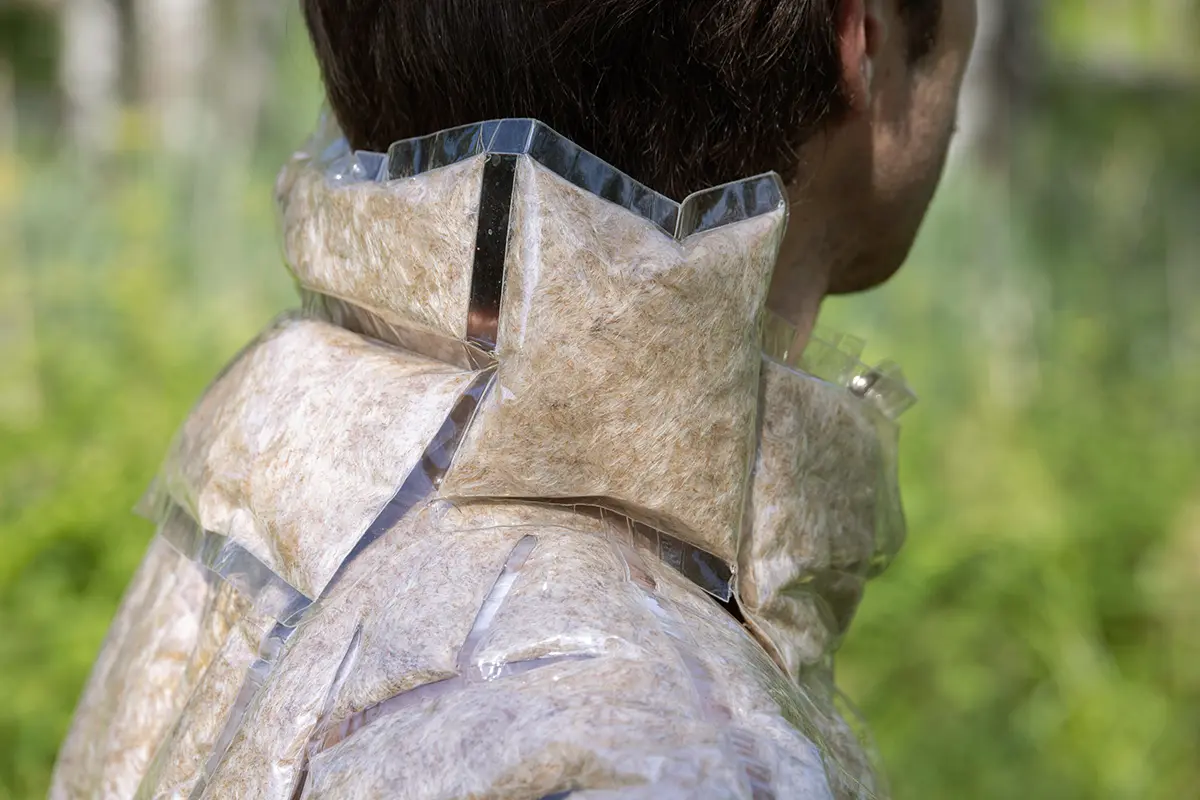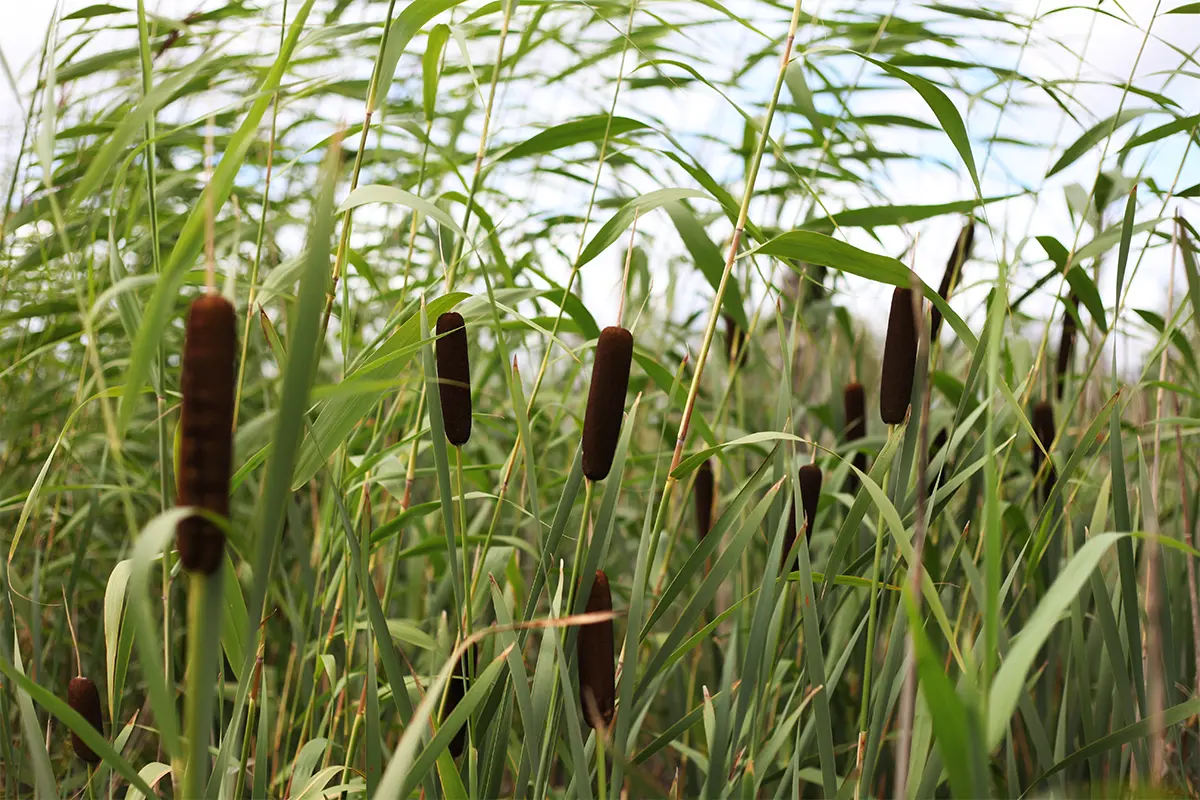This Finland-based start-up is looking to replace fossil and animal-based filling materials with a plant-based one: the result includes carbon-negative promotion and peatland restoration
When thinking about making the world more sustainable, we look at reducing single-use plastic, encouraging the use of public transport and avoiding waste in the fashion industry. How about reverting to plant-based fill materials? Life cycle assessments have long compared the two most abundant materials in this sector: ‘polyester’ and ‘down and feather’. «There are billions of ducks and millions of geese getting killed everyday for the filling industry», explains Amir Tahvonen, art director at Fluff Stuff. The Finland-based start-up aims to create a more sustainable alternative filling material from cattail.
What is the role of filling materials in different industries?
The industry is closely interlinked to that of the fashion industry, especially when it comes to winter-wear such as coats. «The market is valued at 6.6 billion US dollars per year for just down and feathers. The polyester filling sector is even bigger», says Tea Auramo, co-founder and strategist at Fluff Stuff. Whilst it may get overlooked by consumers, the filling materials industry expands in a variety of sectors. «Of course everything is relative,» continues Auramo. Compared to the leather industry, down and feather could be considered as more sustainable given the size.
Then, when comparing polyester to down and feather, many factors come into play. Considering animal use, polyester isn’t linked to farming them. However, its toxicity and lack of degradation is a factor which plays against sustainability. Yet, down and feather encourages mass farming, a separate issue contributing to climate change. Therefore, whilst the current filling material industry has two big players, more sustainable alternatives are needed. Plant-based solutions, for example, would not only act directly on the unsustainable nature of this specific industry, but it would extend to other ones such as fashion, home-wear and even construction.
A ban on fur opens doors for future bans on animal products in the fashion industry
The European Citizens’ Initiative ‘Fur Free Europe’ has received over one million signatures. The petition calls the EU to ban fur farms and to ban farmed fur products from the European market. Having reached that amount of signatures, the European Commission is obliged to respond and take action. «This is a similar movement where we are trying to cover the basis to encourage sustainable and plant-based products», says Auramo. The use of leather and fur in the fashion industry have the same scope as that of the filling sector; to keep consumers warm.
Presenting the market an alternative at this time could be beneficial to encourage a more sustainable consumption. Not only that, but a ban of fur products could lead to future petitions to ban other animal-based products. One example of this is the down and feather market. «It is a question of time. Any day now there may be a ban of down and feathers,» Auramo continues.
The Fluff Stuff case — plant-based filling materials
The company officially started this year and everything is still in the research and planning stage. At the Kiuas Accelerator, Auramo and other co-founder, Lukas Schuck discussed possible usages for the cattail plant. It has numerous beneficial properties to it including restorative, ecosystem services and a good capture mechanism. Fossil and animal based fillings have been the go-to product for generations. They realized that the plant-based filling material market was almost left untouched.
The beneficial properties of cattail and what it means for peatland restoration
The material is 100% made from cattail. Its cultivation presents the market with another scope: to be carbon-negative. «If we get it going as we plan, the rewetting process of the land, which is peat moss, will turn it into carbon sinks, rather than emitters,» explains Tahvonen. «This is because when they are drained, they release carbon dioxide into the atmosphere whereas we would be doing the reversal of that process».
The company needs to go further down the value chain to «ensure that this is a substantial claim.» Auramo has since taken up botanics to learn more about cattails and its properties. «It is actually a super plant,» she says. «You have to be careful, however, because it’s an invasive plan». Its planting and harvesting must therefore be done under supervision of an expert.
It has other ecosystem services which could promote a more circular economy in terms of agriculture. Cattail grows back every year independently. It is also considered as one the best runoff plants. «You can also use it for urban infrastructure to capture runoff water from concrete environments. It has a good capture mechanism,» explains Auramo. Additionally, it acts as a buffer zone plant, useful to capture excess fertilizer. This could reduce the risk of algae bloom and eutrophication.
Becoming carbon-negative with the help of peatlands
Cattails are usually found in dense water marshes and other wetlands. Peatlands are terrestrial wetland ecosystems. Their waterlogged conditions prevent plants from decomposing. Its other properties encourage cattails to grow in those conditions. One detail to the cultivation of cattail is that it must not get dry. Therefore, promoting its harvest would discourage peatlands from getting drained, a factor which would otherwise emit more carbon dioxide into the atmosphere.
In the past, peatlands were drained as it was more economic to turn it into land for livestock farming. This is not news, however. In 2018, Aldert van Weeren, a farmer in Finland, came forward with his research in planting cattails. He found that it could prevent soil subsidence by ninety percent. Rewetting peatlands has both a positive and negative side. Whilst it does promote plant health, this type of land could start to emit methane as a natural response. However, this detail is relatively small when considering all the other benefits.
Auramo also mentions that going forward with this type of cultivation, would incentivize other farmers from harvesting the plant. It would not only promote a more sustainable ecosystem, but it would generate another form of income for those in the agricultural sector. «Time is on our side. Europe has these goals to become carbon negative and they have already identified peatland as one of the biggest solutions for doing this».
Price competitiveness in a new territory — developing new harvesting tools
Regarding costs, the final product would be considered as premium, according to Tahvonen. Its cultivation and nature of production is more costly than other more developed practices. However, Auramo talks about the target customer: «First come the values and aesthetics. Then comes the price point, which is only the third decisive aspect of their purchasing decision.» Tahvonen agrees, pointing out that looking at the fashion industry, it is clear that consumers are changing their decision-making habits.
«Consumers are becoming more aware, and are using this as a purchase decision.» Whilst the price point may be elevated, this could also be due to how new plant-based filling materials are. In relative terms, more R&D needs to get done when it comes to scaling up. In their current development, Auramo says that they collaborated with the robotics department at Aalto University. The aim was to create new tools dedicated to the harvest of cattail in peatlands. «The cultivation is about twenty-six percent more efficient with these newly developed tools,» she says. Therefore, like with any other industry, with time, the product could become more price competitive as it scales up.
Could cattail be the future filling material?
The final marker is how cattail performs as a filler material. According to Tahvonen, heat retention is about eighty percent compared to down and feather. However, he mentions that these tests were done as a raw material. Additionally, the material does not absorb as much water as down and feather: «It is superior in that aspect».
Standardization and industrialization are still under way for the plant-based filling industry. However, with continued pressure from animal and environmental activists, these types of innovations very quickly act as a viable alternative. As Auramo said, it isn’t really a question of ‘if’, but ‘when’.
Fluff Stuff
Co-founded by Tea Auramo and Lukas Schuck in Finland. They are currently testing a developing a plant-based filling material made from cattail which would restore peatlands, be carbon-negative and act as an alternative to fossil and animal based filling.




















